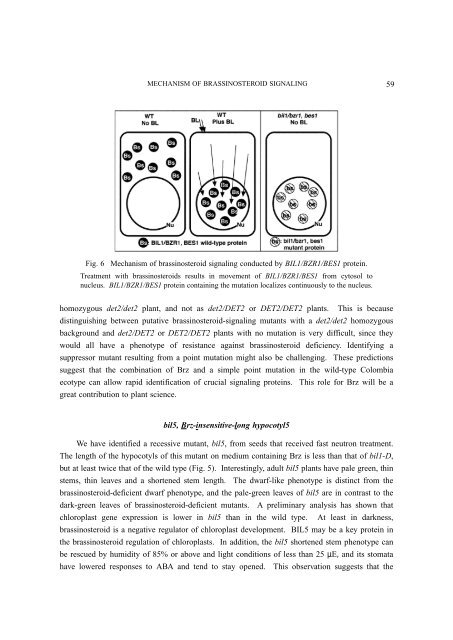No.42 - è¾²æ¥çç©è³æºç 究æ
No.42 - è¾²æ¥çç©è³æºç 究æ
No.42 - è¾²æ¥çç©è³æºç 究æ
Create successful ePaper yourself
Turn your PDF publications into a flip-book with our unique Google optimized e-Paper software.
MECHANISM OF BRASSINOSTEROID SIGNALING<br />
59<br />
Fig. 6 Mechanism of brassinosteroid signaling conducted by BIL1/BZR1/BES1 protein.<br />
Treatment with brassinosteroids results in movement of BIL1/BZR1/BES1 from cytosol to<br />
nucleus. BIL1/BZR1/BES1 protein containing the mutation localizes continuously to the nucleus.<br />
homozygous det2/det2 plant, and not as det2/DET2 or DET2/DET2 plants. This is because<br />
distinguishing between putative brassinosteroid-signaling mutants with a det2/det2 homozygous<br />
background and det2/DET2 or DET2/DET2 plants with no mutation is very difficult, since they<br />
would all have a phenotype of resistance against brassinosteroid deficiency. Identifying a<br />
suppressor mutant resulting from a point mutation might also be challenging. These predictions<br />
suggest that the combination of Brz and a simple point mutation in the wild-type Colombia<br />
ecotype can allow rapid identification of crucial signaling proteins. This role for Brz will be a<br />
great contribution to plant science.<br />
bil5, Brz-insensitive-long hypocotyl5<br />
We have identified a recessive mutant, bil5, from seeds that received fast neutron treatment.<br />
The length of the hypocotyls of this mutant on medium containing Brz is less than that of bil1-D,<br />
but at least twice that of the wild type (Fig. 5). Interestingly, adult bil5 plants have pale green, thin<br />
stems, thin leaves and a shortened stem length. The dwarf-like phenotype is distinct from the<br />
brassinosteroid-deficient dwarf phenotype, and the pale-green leaves of bil5 are in contrast to the<br />
dark-green leaves of brassinosteroid-deficient mutants. A preliminary analysis has shown that<br />
chloroplast gene expression is lower in bil5 than in the wild type. At least in darkness,<br />
brassinosteroid is a negative regulator of chloroplast development. BIL5 may be a key protein in<br />
the brassinosteroid regulation of chloroplasts. In addition, the bil5 shortened stem phenotype can<br />
be rescued by humidity of 85% or above and light conditions of less than 25 µE, and its stomata<br />
have lowered responses to ABA and tend to stay opened. This observation suggests that the













